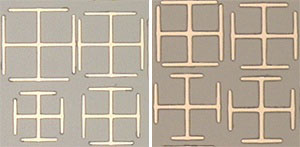| Dec 08, 2010 | |
Metamaterials: Designed for a response |
|
| (Nanowerk News) Terahertz radiation—a type of electromagnetic radiation that falls between microwave and infrared—can pass through a variety of non-conducting materials, such as clothing, wood and plastic. Terahertz radiation is therefore ideal for medical imaging and security screening, and is perfect for communication and astronomy because of its ability to penetrate through fog and cloud. However, terahertz-band technology has a fundamental weakness: detecting terahertz signals is almost impossible using conventional materials because such materials do not generate the desired electromagnetic response. For this reason, many scientists have turned to artificial materials for answers. | |
 Two examples of hybrid metamaterials consisting of a planar array of split ring resonators of various sizes. Metamaterials are artificially designed materials with extraordinary electromagnetic properties. They are designed and fabricated using periodic microstructures in such a way as to interact with and manipulate electromagnetic radiation. Most scientists involved in metamaterials research are focusing on using the technology for making invisibility cloaks and perfect lenses, but there is much more that metamaterials can do. Some studies have demonstrated the possibility of achieving an electromagnetic response to terahertz waves in metamaterials by altering the dimensions of the scattering elements, called split ring resonators (SRRs). However, so far such studies have only achieved this type of response for radiowave, microwave, infrared and visible wavelengths—not for terahertz radiation. Researchers at the A*STAR Data Storage Institute and the National University of Singapore ("Hybrid metamaterial design and fabrication for terahertz resonance response enhancement"). have now enhanced the electromagnetic response of metamaterials in the terahertz regime by arraying SRRs of various sizes in the same metamaterial (see image). To fabricate the metamaterials, the researchers patterned silicon substrates by photolithography to form planar arrays of SRRs, and then applied a lift-off process to obtain the metamaterial in its usable form. Using terahertz time-domain spectroscopy to measure the electromagnetic responses of metamaterials with various SRR patterns, they found that the resonant response of 'hybrid' metamaterials consisting of SRRs of various sizes was up to 364 times that of metamaterials made up of uniform SRRs. The transmission spectra of the hybrid metamaterials showed broad resonance peaks, demonstrating that the material responds to terahertz radiation in a way that could be used for signal detection. The researchers found that the characteristics of the resonant peaks were dependent not only on the sizes of the SRRs, but also on the separation between them: resonant peaks became broader as SRRs were brought closer to each other. Computer simulations showed that there was strong mutual coupling between adjacent SRRs. |
|
| The researchers could tune the resonant response by varying the SRR design—a novel approach to realizing tunable and sensitive metamaterials for detecting terahertz radiation. |
| Source: A*STAR |
